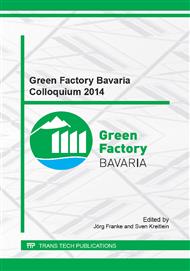p.21
p.27
p.35
p.41
p.47
p.53
p.61
p.69
p.75
Identifying Energy Efficiency Potentials by Applying Flexible Measuring Systems
Abstract:
This paper presents a flexible measuring system to identify energy efficiency potentials in the context of the ISO 50001 standard. On the basis of five essential requirements the flexible measuring system was structured into 4 modules which can be separately extended or modified. As the flexibility was in focus of the development this system it is able to measure the energy consumption on a very detailed level of the components of a machine. In addition it can also acquire measurement data of different other sensor signals like temperatures, flow rates etc. To evaluate the usability of the system in order to identify energy efficiency measures a use case was conducted. Results of the measurement data as well as possible energy savings of the investigated machinery are discussed at the end of this paper.
Info:
Periodical:
Pages:
47-52
Citation:
Online since:
October 2014
Authors:
Price:
Сopyright:
© 2014 Trans Tech Publications Ltd. All Rights Reserved
Share:
Citation:


